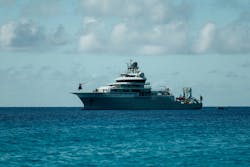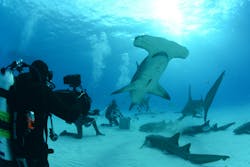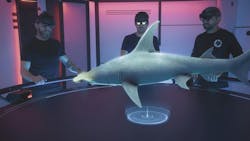Mixing Augmented Reality with Sharks
What you’ll learn:
- How OceanX explorers utilize augmented reality.
- What tools were used to generate the 3D views of sea life?
If you’re looking to stream some interesting video, then check out James Cameron’s “OceanXplorers” series on National Geographic. It has sharks and augmented-reality (AR) headsets just to make things fun. The crew that included scientists and videographers sailed on the OceanX science vessel designed for research and multimedia (Fig. 1). We had a special look at the AR support in the video (watch the video above).
The OceanX supports a helicopter and two submersibles: the Neptune and Nadir. Each is capable of diving to depths of 1,000 meters. They can operate up to three days at a time. There’s also a media studio on-board that provides the AR support.
The cameras used to record the animals in their environment included the Canon C300mk2 with Sigma Prime Lenses (Fig. 2). The first episode examines sharks, while subsequent episodes look at other sea life such as whales.
The exploration and presentation of the conventional video is informative. However, it’s the AR that takes the research to the next level. Ncam Reality made the recording possible and the Unity game engine was leveraged to render the 3D images via Microsoft's Hololens 2 (Fig. 3).
Augmented reality allows scientists to view not only the exterior we normally see, but also examine extrapolated details of the interior of an animal.
The Hololens 2 is now targeting industrial applications in this manner. A host of other AR glasses as well as mixed-reality headsets like Meta’s Quest 3 provide AR support that would be capable of viewing these 3D images.
The BBC’s Orla Doherty noted, “Creating 3D holograms on a moving ship during a mission, either to plan an experiment beneath the waves or to analyze results from a mission, was a technological hurdle that challenged everybody involved, from the team at Microsoft who grappled with oceanographic data streams and engineering complexities, to the team at OceanX who marshalled their ideas to the team at Ncam whose clever cameras were able to capture the OceanXplorers AND their holograms all together in camera!”
About the Author
William G. Wong
Senior Content Director - Electronic Design and Microwaves & RF
I am Editor of Electronic Design focusing on embedded, software, and systems. As Senior Content Director, I also manage Microwaves & RF and I work with a great team of editors to provide engineers, programmers, developers and technical managers with interesting and useful articles and videos on a regular basis. Check out our free newsletters to see the latest content.
You can send press releases for new products for possible coverage on the website. I am also interested in receiving contributed articles for publishing on our website. Use our template and send to me along with a signed release form.
Check out my blog, AltEmbedded on Electronic Design, as well as his latest articles on this site that are listed below.
You can visit my social media via these links:
- AltEmbedded on Electronic Design
- Bill Wong on Facebook
- @AltEmbedded on Twitter
- Bill Wong on LinkedIn
I earned a Bachelor of Electrical Engineering at the Georgia Institute of Technology and a Masters in Computer Science from Rutgers University. I still do a bit of programming using everything from C and C++ to Rust and Ada/SPARK. I do a bit of PHP programming for Drupal websites. I have posted a few Drupal modules.
I still get a hand on software and electronic hardware. Some of this can be found on our Kit Close-Up video series. You can also see me on many of our TechXchange Talk videos. I am interested in a range of projects from robotics to artificial intelligence.



